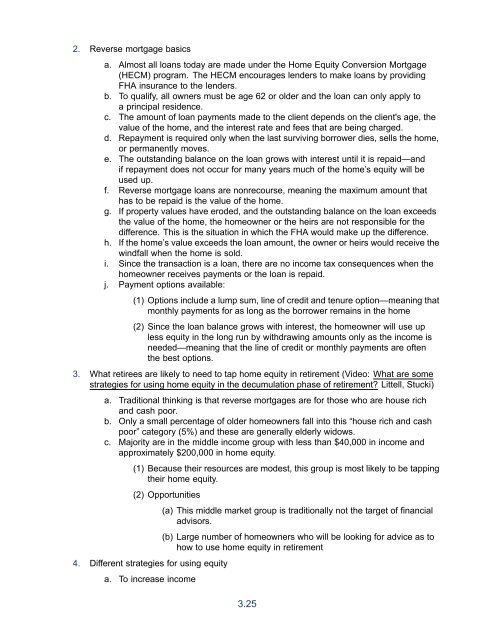section 1 - The American College Online Learning Center
section 1 - The American College Online Learning Center
section 1 - The American College Online Learning Center
Create successful ePaper yourself
Turn your PDF publications into a flip-book with our unique Google optimized e-Paper software.
2. Reverse mortgage basicsa. Almost all loans today are made under the Home Equity Conversion Mortgage(HECM) program. <strong>The</strong> HECM encourages lenders to make loans by providingFHA insurance to the lenders.b. To qualify, all owners must be age 62 or older and the loan can only apply toa principal residence.c. <strong>The</strong> amount of loan payments made to the client depends on the client's age, thevalue of the home, and the interest rate and fees that are being charged.d. Repayment is required only when the last surviving borrower dies, sells the home,or permanently moves.e. <strong>The</strong> outstanding balance on the loan grows with interest until it is repaid—andif repayment does not occur for many years much of the home’s equity will beused up.f. Reverse mortgage loans are nonrecourse, meaning the maximum amount thathas to be repaid is the value of the home.g. If property values have eroded, and the outstanding balance on the loan exceedsthe value of the home, the homeowner or the heirs are not responsible for thedifference. This is the situation in which the FHA would make up the difference.h. If the home’s value exceeds the loan amount, the owner or heirs would receive thewindfall when the home is sold.i. Since the transaction is a loan, there are no income tax consequences when thehomeowner receives payments or the loan is repaid.j. Payment options available:(1) Options include a lump sum, line of credit and tenure option—meaning thatmonthly payments for as long as the borrower remains in the home(2) Since the loan balance grows with interest, the homeowner will use upless equity in the long run by withdrawing amounts only as the income isneeded—meaning that the line of credit or monthly payments are oftenthe best options.3. What retirees are likely to need to tap home equity in retirement (Video: What are somestrategies for using home equity in the decumulation phase of retirement? Littell, Stucki)a. Traditional thinking is that reverse mortgages are for those who are house richand cash poor.b. Only a small percentage of older homeowners fall into this “house rich and cashpoor” category (5%) and these are generally elderly widows.c. Majority are in the middle income group with less than $40,000 in income andapproximately $200,000 in home equity.(1) Because their resources are modest, this group is most likely to be tappingtheir home equity.(2) Opportunities4. Different strategies for using equitya. To increase income(a) This middle market group is traditionally not the target of financialadvisors.(b) Large number of homeowners who will be looking for advice as tohow to use home equity in retirement3.25
















